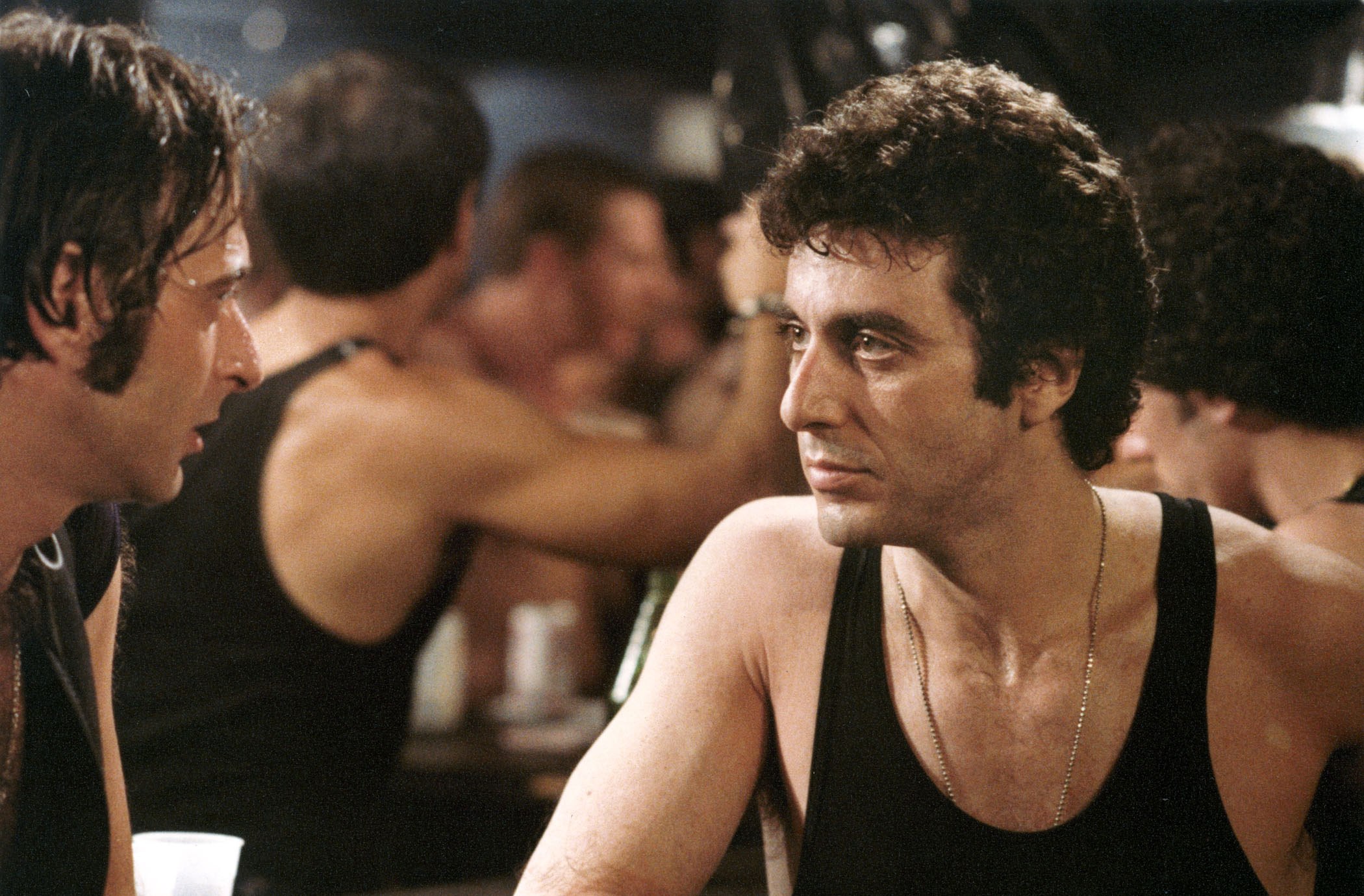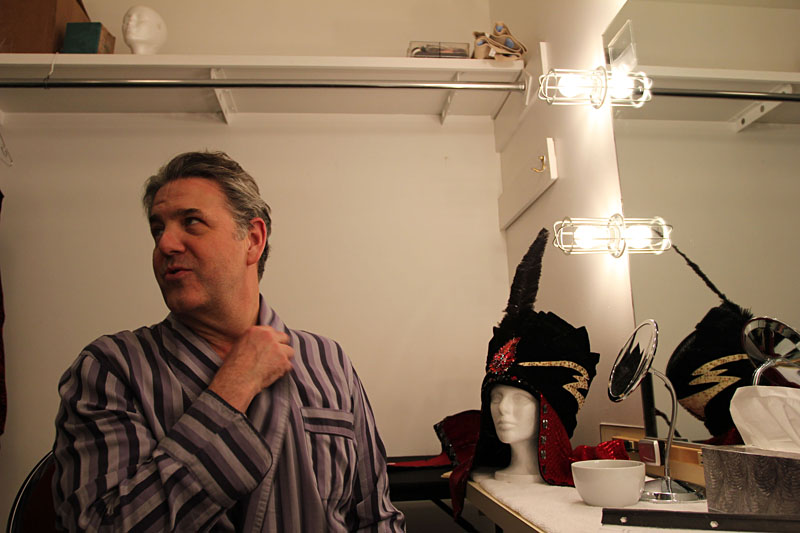To watch Al Pacino boogie onscreen in a leather bar after inhaling from a hanky soaked in amyl nitrate is to know just how homosexual he is not. The closest comparison to the hilarious inauthenticity of Cruising would have to be Neil Diamond in The Jazz Singer, also released in 1980, convincing an African-American nightclub crowd that he’s one cool brother when he really starts to rock (in blackface, yet). William Friedkin’s controversial failure featured popper-sniffing Pacino as a cop going undercover as gay bait for a serial killer. It caused angry gay protests while being shot in Greenwich Village. Yet the once-reviled Cruising is now often screened for gay men who see in it . . . well, what, exactly?
Witness the new “docu-fiction” movie Interior. Leather Bar., in which co-directors James Franco and Travis Mathews ponder the 40 minutes Friedkin excised from Cruising to avoid an X rating. No DVD restoration has yet let us glimpse what Friedkin thought was too much in a movie still full of excess. So what got cut?
“Pure pornography,” Friedkin explained to Franco, as he recalled in an interview on the website Flavorwire last May. Friedkin got full access to the gay private club The Mineshaft and shot “fist-fucking and golden showers and a lot of things that remain [in the movie], but not to the extent that I filmed them.”
No elbow grease or torrential downpours are included among Interior’s sex acts. The movie hints at recreating that missing footage, but is instead an appealingly shaggy film-within-a-film about making a movie in which everyone’s boundaries are being pushed to the limit. Franco, Mathews, and actor Val Lauren (their Pacino stand-in) discuss risk and assimilation, while the rest of their ensemble (straight and gay) approximates Cruising’s sex-drenched milieu with varying degrees of discomfort. Seeing those scenes enacted becomes a kind of homage to sexual freedom in general and Friedkin’s film in particular.
You have to watch
Cruising again to understand what an odd proposition this is, because most of what’s in that film is nothing to applaud. In a plot that plays out like a graphic gay episode of Charlie’s Angels, Pacino is tarted up in tight Ts and sent to the Village because he looks like the serial killer’s sexy prior victims. Cut to Pacino moving into the gayborhood, where his cute new neighbor catches him tossing out piles of the ex-tenant’s porn mags Honcho and Blueboy, which are referred to by the neighbor as “exotic tastes.” This is like calling your older brother’s stolen Penthouse collection “mysterious.”
Pacino paints his eyebrows before heading out to a butch bar. Pacino pumps iron in front of his mirror while shouting, “YES! YES!” Pacino, still undercover, is questioned by detectives at the station along with a young man who hogtied him during a hookup—nice ass, Al, by the way—when, for reasons no sane viewer can explain, an immense black cop, wearing only a jockstrap, boots, and a cowboy hat, stomps into the interrogation room, slugs Pacino in the face, and leaves. It’s more baffling then campy.
Pacino finally catches the culprit—after propositioning him in Central Park with the come-on “Lips or hips?”—then returns to respectable life with girlfriend Karen Allen. But, in the movie’s most infamous twist, it’s implied that he’s been irreversibly affected by the experience, and offed the likable neighbor to whom he’d begun to take a shine. What happens in Greenwich Village doesn’t stay in Greenwich Village.
Subtle Cruising ain’t. It is, after all, the product of a man whose most successful movie looks upon the satanic possession of pea soup–spouting Linda Blair with grave seriousness. But at least The Exorcist doesn’t feel like foreign territory to the director. Friedkin, who told Flavorwire he doesn’t identify as either gay or straight, displays curiosity in Cruising but no control. He’s contemplative but clueless. You get the uncomfortable feeling he’s unintentionally working through the same sexual panic he’s written into Pacino’s character—or, worse, that the film could’ve been made by the killer. (He’s later revealed to be a brooding guy, working on a thesis about American musical theater, who’s stabbing lovers at the request of his dead father. Oy.) Cruising even fetishizes the deaths: When one stud is trussed up pre-murder, naked and beautiful and begging for mercy, it seems an extension of the tough-talking foreplay. “You made me do it,” the killer tells his victims. And Cruising is not so sure it disagrees.
“I don’t think Friedkin went into [Cruising] with any bad intentions or bad faith or anything,” Franco said in a recent Huffington Post interview. “After a while, it had to have been clear to him that the juxtapositions of these murders with the gay clubs was upsetting people, because it made some unfortunate connections that . . . this lifestyle led to depravity and murder.”
Well, yes and no. “I had no agenda,” Friedkin told Flavorwire. “I do understand that clearly a lot of people in the movement felt that this would set back the movement and was not the best foot forward for the gay community. When I started the project, I had no inkling of that.” Yet Friedkin also elaborates on connections between the scene at The Mineshaft, “the undefined AIDS epidemic,” and the real-life gay killings used as the film’s inspiration, which he says were “happening, basically, in a similar environment. That’s what attracted me [to the subject matter].”
Friedkin overreached. He was not the right artist to be messing with gay men, murder, and an AIDS metaphor. Someone thoughtful could indeed make a dark, dangerous film out of such concerns—and in fact someone did: Alain Guiraudie, whose stunning new French thriller Stranger by the Lake features a main character having graphic unprotected sex with a man he’s sure has just drowned a guy. It’s bound to cause anger. It should—but it’s the right kind of anger. Characters are killed or disturbingly transformed to provoke debate about intimacy, the pull of passion, and the importance of community. By contrast, Cruising’s characters are slain or turned monstrous for getting lost in their desires, and that’s the end of the discussion. (Stranger opens at SIFF Cinema Uptown on March 7.)
Interior’s Mathews, a gay filmmaker, and Franco, whose sexual orientation is anyone’s guess, want to get lost in their urges. They don’t possess Friedkin’s technical finesse, but they do know where he went wrong with his thinking—and are sharp enough to show us what’s compelling about his mistakes. Interior. Leather Bar. embraces the fascination that Friedkin warped. Friedkin finds the gay sex frightening; Franco, calming the straight, nervous Lauren, calls the frank action they’re watching from the sidelines “beautiful.” Friedkin ends his film with Pacino looking at himself in the mirror, undone by his new feeling for men. Franco and Mathews end theirs with affecting individual shots of each actor cruising us—and they want us to feel something for them.
So if you see
Interior. Leather Bar., should you then walk over to Scarecrow and rent Cruising? Sure. If you suppress all your critical faculties, the movie unrolls like a gonzo mix of hot guys, hot sex, and authentic New York City locations during a fabled time of gay sexual liberation. Both Friedkin and Franco like to watch. It’s crucial to consider what’s behind their stares.
film@seattleweekly.com









